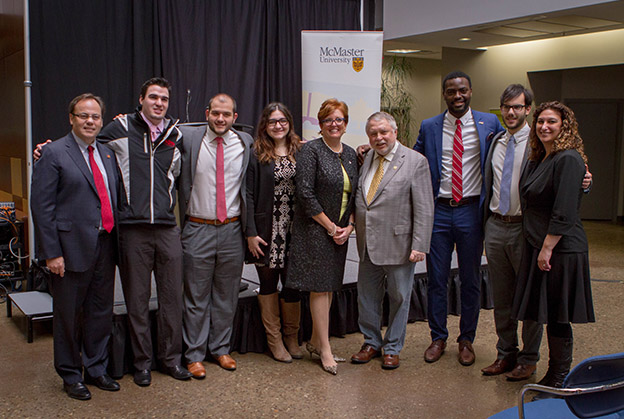New Ontario Student Grant to make college, university more accessible

Official announcement was made this morning at McMaster Innovation Park by Eleanor McMahon, MPP for Burlington. Pictured left to right: Ron McKerlie, Luke Baylis, Daniel D'Angela, Giuliana Guarna, MPP Eleanor McMahon, MPP Ted McMeekin, Ehima Osazuwa, Spencer Nestico-Semianiw, and Allison Sekuler
Ontario is making college and university more accessible and affordable for low- and middle-income students in the Burlington-Hamilton region through the single-largest modernization ever of the Ontario Student Assistance Program (OSAP).
As announced in the 2016 Budget, the government will create a single, targeted, non-repayable grant — the Ontario Student Grant — starting in the 2017-18 school year.
The changes to OSAP will make average tuition free for more than 150,000 eligible low- and middle-income students across the province and will reduce the cost for many more by:
- Providing the majority of eligible students whose parents earn the median annual income of $83,300 or less with enough in grants to more than cover their tuition costs
- Eliminating provincial student loan debt for eligible students whose parents earn less than $50,000
- Ensuring that no eligible student receives less non-repayable aid through the new grant than they currently do through the 30% Off Ontario Tuition Grant
The Ontario Student Grant will provide additional support for full-time mature and married students, and eligibility will no longer be tied to the number of years a student has been out of high school.
This predictable, upfront grant will allow families in our area to plan for their education on the basis of net price — the difference between the sticker price of tuition and what a student actually needs to pay.
“The new program ensures that generations to come will share equal and direct access to one of the world’s most valuable resources: knowledge. Knowledge that will spark innovation, quench curiosity, and enrich the future of students and, subsequently, of all Ontarians,” said Allison Sekuler, McMaster’s acting vice-president research. “The Ontario budget also recognizes the critical nature of research at Ontario’s Universities, and the role Universities play in innovating and driving the economy.”
The government will work closely with the postsecondary sector to develop planning tools that more accurately calculate the net tuition and net price of a university or college education.
Breaking down barriers to postsecondary education the Burlington and Hamilton region is part of the government’s economic plan to build Ontario up and deliver on its number-one priority to grow the economy and create jobs.
The four-part plan includes investing in talent and skills, including helping more people get and create the jobs of the future by expanding access to high-quality College and university education.
The plan is making the largest investment in public infrastructure in Ontario’s history and investing in a low-carbon economy driven by innovative, high-growth, export-oriented businesses. The plan is also helping working Ontarians achieve a more secure retirement.


